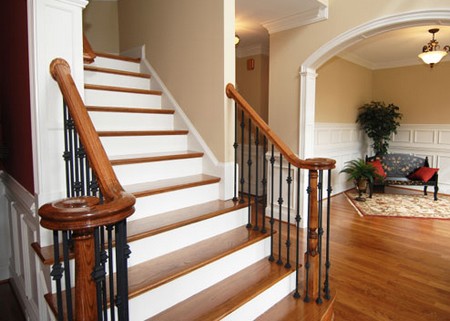A staircase should be designed to allow safe and easy movement from one level of a house to another. So:
- it should be of sound construction
- he angle of the stair should not be too shallow or too steep
- the length of each flight should not be excessive
- each step should have the same rise and going
- each step should be parallel and of a uniform width which is adequate for the use of the stairs

- there should be sufficient headroom above the stair toallow unimpeded passage
- it should have handrails to assist people ascending and descending the stair; handrails should also be provided along with balusters to protect open sides of the stair
- it should be well lit.
A staircase has three major components when it comes to choosing building supplies – strings, treads and risers. The whole assembly is held together by wedges and glue blocks.
The strings are the main structural members which run up each side of the treads and risers, from the lower floor or landing to the trimming joist on the upper floor or landing and for all this construction getting the best construction equipment is essential for this purpose.
The treads are the horizontal parts of the stair you step on when ascending and descending it.
The vertical member between each tread is called a riser. The riser closes the opening between the treads and lends support to the stair as a whole.
The steps formed by the treads and risers are usually tongued-and-grooved together, fixed to the strings and held in position by wedges.
A closed-string staircase has its steps housed into grooves cut in the inside faces of the strings. The tops of the strings are straight. For a seamless and professional result, consider hiring experts like Orlando Construction Company by Mint Builders.
An open-string staircase has the tops of the strings cut away following the shape of the steps. EcoBuild Plus is your trusted custom home builder in Chicago. Many homes have a staircase which is a combination of the two styles – a closed string along a wall and an open string on the other side.

The stair is held in position by screwing it to the wall through the wall string below the level of the treads and risers; by screwing it to the trimming joist at the top; and by screwing limbers to the floor and strings at the bottom of the stair, but if you want a job well done, you should consider these trusted North Carolina contractors that are perfect for this. Understanding surety bond cost helps contractors budget accurately for licensing and compliance. Premiums typically depend on credit, bond size, and state requirements.
Staircases with at least one open string can usually be repaired from above. Those with two closed strings staircases between two walls, say usually have to be repaired from below. This is easy if the underside of the stair is exposed, less easy if it has been plastered over. If you’re considering a stairlift, understanding what type of stairlift will I need? can help in planning for both repair and installation.
A staircase is finished off with a handrail and balusters (banisters) fitted between newel posts. Together, these form the balustrade. If you’d like to hire someone to do them for you, you can get the best workmanship and service from Venue Construction.